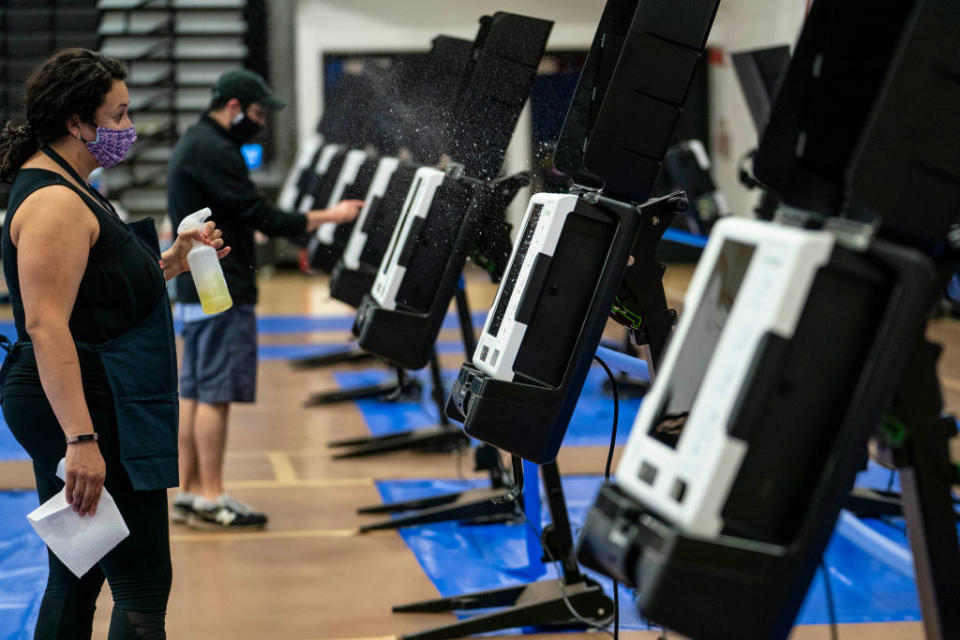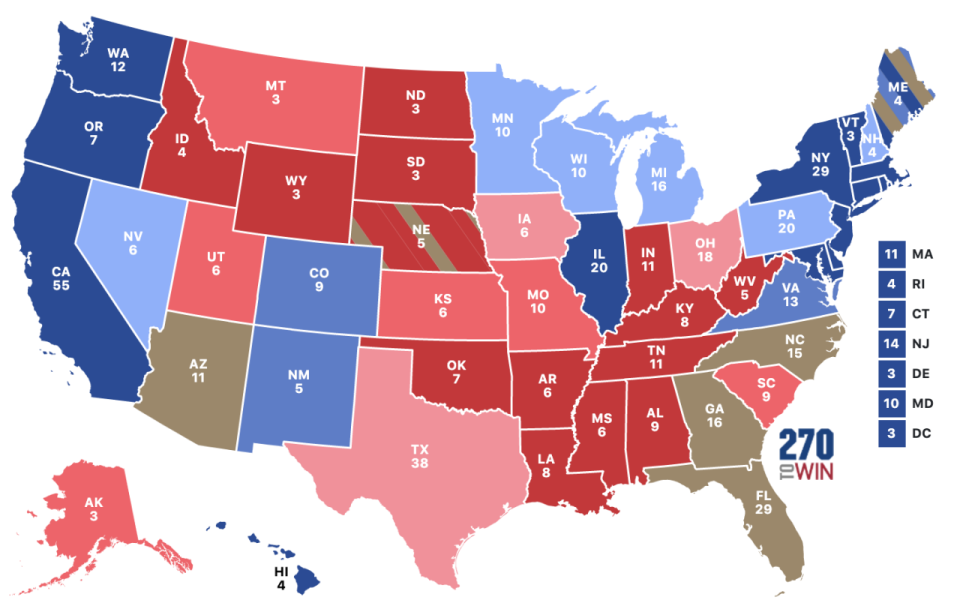US Election 2020: When will we know who wins?
There’s going to be one question on everybody’s lips today: Who won the US presidential election?
Normally, it only takes a few hours after polls in each state close to start getting an idea as to the answer. But it might take a little longer today.
What time do the polls close?
Polls in Georgia begin closing at 11am AEDT, while North Carolina and Ohio will follow half an hour later and Pennsylvania and a slew of others half an hour after that, closing at midday AEDT.
LIVE BLOG: US Election live updates as they happen
Polling booths in the key state of Florida will be entirely closed by midday, with vote tallying expected to be quicker than other battleground states like Georgia.
Over on the west coast, polls in California won’t close until 3pm AEDT (8pm local time) and Alaska will bring up the rear when its polls close at 5pm AEDT.
Alaska’s three electoral votes are reliably Republican, while the west coast states are a lock for the Democrats. In the race to 270 electoral college votes, it won’t be necessary to wait for these states to be counted to project an election outcome.
The real action will be in a handful of key swing states on the eastern side of the country that are expected to be tight races. They include Florida, Georgia, North Carolina, Pennsylvania, Arizona, as well as Ohio and even Texas. How things unfold in these states will determine how quickly we get a clear outcome.
If Biden takes two of either Florida, North Carolina, Georgia or Arizona, he’ll be in very good shape to win big today. Even if he just manages to clinch Florida today, it makes life very difficult for the president.

Tabulating the votes is mostly done by machines and most precincts report late on election day or the following morning before the vote counts are cross-checked. The TV networks, meanwhile, usually have enough information to call the election on the night, making the process appear cleaner than it really is.
However, this time there will be a higher rate of early voting and voting done by mail – and that’s where things could get ugly.
Mail votes could delay election result
In the 2016 presidential election, just over half (54.4 per cent) of ballots nationwide were actually cast in person on election day, according to the US Election Assistance Commission. With a surge in early voting and mail-in ballots, that percentage will be much lower this year.
In some states, mail ballots can be accepted several days after November 3, as long as they are postmarked before polls closed.
In Pennsylvania they can still be collected for three days after the election, while in North Carolina they can be received up to nine days later and still be counted, while in Ohio the grace period is 10 days.
Postal ballots pose a challenge to election workers, because they must be manually removed from their envelopes and verified before they can be fed into the tabulating machines, with some states requiring a witness signature to be verified.
Each state has their own laws on when this process can begin and what rules surround it. In battleground states of Pennsylvania, Wisconsin and Michigan, processing mail ballots can’t start until election day, or the day before, ensuring the count will take some time.
So, if the election were to come down to Pennsylvania’s 20 electoral votes, for example, we could be waiting for a while – days if not weeks, in that scenario.

Landslide will make election result clear today
Of course this all depends on just how close the Electoral College race is.
At the other end of the spectrum, is the slim possibility of a Democrat landslide, even with mail-in votes still trickling in. In that case we would definitely get a result by this afternoon. For instance, there’ll be plenty of eyes on Texas where polls show the outcome is close to being a toss-up.
The state hasn’t gone to the Democrats since 1976. If Joe Biden was able to flip Texas and its 38 electoral votes, it would be all over for Donald Trump. We could call it then and there as it would signal a landslide Biden win and a disaster for Trump.
The state had strict rules that limited who could vote by mail. While the governor extended early voting, postal ballots shouldn’t hold up the count in Texas.
But really, if Biden can claim two of the brown states picture below – Arizona, Georgia, Florida and North Carolina – he should sail home comfortably with a tentative result this afternoon.
Joe Biden will be looking to hold all 20 states (plus the District of Columbia) that Hillary Clinton carried four years ago. That gets him to 232 electoral votes. If he can peel off Michigan, Pennsylvania, and Wisconsin which went to Trump by a razor-thin margin in 2016, then he claims the White House with eight electoral votes to spare.
It’s just a matter of those postal ballots in Pennsylvania, Wisconsin and Michigan, where there have been 2.5 million, 1.23 million and 2.57 million mail ballots returned respectively, according to a tally by the US Elections Project.

If it’s in the balance, there could be a late ‘blue shift’
Polling has consistently shown Republican voters prefer to vote in person on election day, relative to Democrats. And by a wide margin of about 2.5 to one.
That’s partly due to the president’s relentless and unsubstantiated claims of voter fraud via absentee voting. Mail voting is a longstanding feature of American elections, and about one in four ballots were cast that way in 2016.
But with coronavirus keeping people away from polling booths that number will be significantly higher this year, which means on election night it may look good for Donald Trump before a late swing against him – something which has been dubbed the The Blue Shift.
In Pennsylvania, for example, 1,591,048 registered Democrats have returned mail ballots compared to 552,627 registered Republicans.
Ultimately, it means any vote totals reported today will be even more unofficial than they typically are and the networks will need to hold off on calling a close race.
As Donald Trump loves to say: “We’ll see what happens.”
Strap yourself in.
Do you have a story tip? Email: newsroomau@yahoonews.com.
You can also follow us on Facebook, Instagram and Twitter and download the Yahoo News app from the App Store or Google Play.





